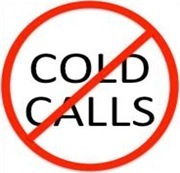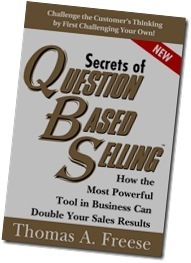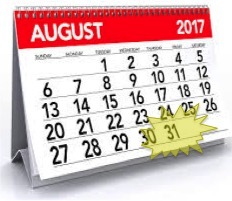Thomas A. Freese's Blog, page 7
March 16, 2017
Stop Making “Cold” Calls, Please…
When contacting new prospects for the very first time, wouldn’t it be great to have a 30% to 50% success rate instead of the standard 1% to 2%? Think about it. If only one or two out of a hundred people actually chooses to engage with you, with the rest of your opportunities going down in flames, it almost seems inhumane to ask someone to continue making that many calls with such a low success rate.
It turns out that making cold calls in 2017 is a bad strategy. Salespeople hate to make them because they incur such a high rate of rejection, and customers hate to take cold calls because they perceive them as useless wastes of time. Consequently, cold calling tends to produce an extremely low return on invested sales effort (ROISE).
Now, I‘m not saying you shouldn’t call prospective customers, nor am I suggesting that you make fewer calls or work less. I’m just saying that you shouldn’t make “cold” calls any more. Fortunately, there is a better way.
What’s the problem with a cold call? The answer is simple: Temperature. Cold calls tend to sound vague and purposeless, rather than valuable, credible or relevant to the person on the receiving end of the call. So, what do you suppose the chances of making a sale are if the customer’s first impression is that this call is probably going to be a waste of time? Perhaps I should just come right out and ask: When is a good time for you to take cold calls from a salesperson you don’t yet know or trust? I think you’d say that it’s never a good time. But, what if it was possible to change the customer’s mentality to be more receptive to your calls?
Let me give you a sample of what a cold call typically sounds like:
Salesperson: “Good afternoon, Mr. Customer, my name is Joe Smith and I’m with Equitable Real Estate Life Insurance Mortgage Company. I wanted to introduce myself and see if there would be a good time to set up a meeting so I can show you how our products could help you manage your short-term monetary goals and well as help with your longer-term financial planning.
Customer: “Ahh…no, thanks.” (click)
Sure, you can mix up the words a bit and pacify yourself by thinking that your cold calls sound much different than the sample above; but at the end of the day, we should care less about what we say, and focus instead on what the customer hears. Without being customer-focused, sellers end up leaving lots of voice- mails that never generate return calls. Same with email—email messages are constantly being sent into the abyss of the decision makers’ inboxes, never to be heard from again. And, if you’re lucky enough to get through to a “live” person, customers have learned the easiest way to get a salesperson off the phone is to either say, “No, thanks…”, or simply ask, “Can you send me information?”
In either case, a potential opportunity is squandered because the salesperson doesn’t sound purposeful, relevant, valuable, or credible. If there was a fix for this, wouldn’t you rather convert more potential opportunities into real prospects? This entire conundrum is explained in Chapter 12 of my first book (Secrets of Question Based Selling), which is appropriately titled, Turning Cold Calls into Luke Warm Calls.
The key to transforming cold-calls into luke-warm calls is to understand that people are generally reluctant to share information with someone they don’t yet know or trust. You can easily prove this theory for yourself. Just walk up to someone you don’t know and ask, “Ma’am, what’s your biggest problem?” What do you think will happen? My money says they’ll give you a dirty look and then walk away.
So, when you call prospects, it’s okay to be pleasant and cordial, but you’ve got to realize that people want to know two things right off the bat: Who you are, and why are you calling me? If you are calling for no reason whatsoever, why bother even making the call? That’s what I mean by being purposeful. But, most sellers are indeed calling for a reason, and it shouldn’t just be to chit-chat about something as superfluous as the customer’s picks for the NCAA basketball tournament.
Instead, there are dozens of ways to sound more purposeful when targeting a specific audience. Note that if I made five prospect calls to five different people, or sent emails to five different accounts , the context of my message may vary widely from one to the next, but my strategy of coming across as a valuable resource rather than just another cold-caller doesn’t change. Here are two examples of conveying a more meaningful message:
Salesperson: “Hi, Robert, this is Chuck Miller with ABC Company, I’m on the team that works with large manufacturing accounts in the Great Lakes Region. I had a meeting with your counterpart in another account, and two issues came up in our conversation just before lunch last Friday that I though might directly impact your manufacturing process; one of which is time sensitive. So, I wanted to be proactive and see if it would make sense for us to connect. Is this a bad time or do you have a few minutes?”
Salesperson: “Hi, Susan, this is Dana Evans with XYZ Company, I’m on the team that works with hospitals in Central Florida. We’ve had a handful of new announcements in the last six and a half weeks, three of which could directly impact your delivery of patient care—at what could be a fraction of the cost. So, I wanted to be proactive and see if it would make sense for us to have a conversation. Did I catch you at a bad time?”
Both of these examples assume that you reached the person “live.” You wouldn’t have asked if it was a bad time when leaving a voice-mail or email message. With the exception of that last sentence, however, you could use these same words to increase the purposeful-ness of your electronic messages. For example, on voice-mail, you could easily say, “If you get a chance today, could you please call me back. My number is ________________.” With email, I might write something like, “To avoid a championship game of telephone tag, might I suggest that we pick a time to get together on the telephone to go over the various options, how that would impact your business and the associated costs? I should be in the office until tomorrow afternoon when I have to catch a flight to Chicago. Let me know what time works best for you. Please advise.”
These calls are intended to sound pleasant and cordial, but they don’t waste the customer’s time by being vague or irrelevant. In fact, being overly friendly prospects hoping that prospects will feel more inclined to buy your product or service will more likely backfire in today’s standoffish selling environment because customer’s don’t want to be schmoozed. They want to be helped. Fortunately for sellers, when your calls sound purposeful, relevant, and credible, and you are perceived to be a valuable resource, you will build plenty of relationships within your targeted accounts. Put it this way, if I was going to make a bunch of prospect calls, I would rather my efforts produce two, three, or even four times the average success rate. Once you get to that point, you double your success rate again. That’s how you sell lots of stuff.
March 9, 2017
Chalk Talks, Flip Charts, & White Boards, …‘Oh my!’
There are only so many ways to communicate value during the typical sales cycle. One is to simply verbalize whatever points you want to make. Relying on words alone, however, means you run the risk of having your messages get diluted, as customers remember only some fraction of what was said. That’s why it’s important to use visuals, as a picture is worth a thousand words.
 The most common visuals sellers use to deliver their value propositions are product brochures and PowerPoint slides—which ironically, isn’t the most productive way to communicate value. Truth be told, the instant you put up a PowerPoint slide, the customer’s eyes go straight to the lower right corner of the image on the screen, and then work backward from the lower right to the upper left. Why? Because skeptical customers have learned over the years that the meat of the messages being presented usually crescendo toward the bottom of the slide. Meanwhile, most salespeople begin by reviewing points in the upper left of each slide, and then slowly (sometimes painstakingly) work their way down to the conclusions in the lower right.
The most common visuals sellers use to deliver their value propositions are product brochures and PowerPoint slides—which ironically, isn’t the most productive way to communicate value. Truth be told, the instant you put up a PowerPoint slide, the customer’s eyes go straight to the lower right corner of the image on the screen, and then work backward from the lower right to the upper left. Why? Because skeptical customers have learned over the years that the meat of the messages being presented usually crescendo toward the bottom of the slide. Meanwhile, most salespeople begin by reviewing points in the upper left of each slide, and then slowly (sometimes painstakingly) work their way down to the conclusions in the lower right.
Can you see the problem? During much of the presentation, the audience is focused on something totally different than the salesperson is presenting. Oops!
If you really want to differentiate your solutions, I suggest you skip the standard PowerPoint deck, and instead grab a set of markers and facilitate the discussion by drawing your own pictures. Whenever I’m the customer, I can review sales propaganda on my own. What I really want is to get a sense for how competent a salesperson is, and whether I’m dealing with someone who can translate generic information into specific solutions that meet my needs.
To cite a practical example, have you ever headed off to the hardware store with a problem you didn’t know how to solve? When the first Mr. Fix-it person gives you a vague answer, what do you do? If you’re like me, you seek out a second opinion. Then, if the second person provides a verbose and convoluted explanation, it’s possible to feel more confused than helped. Finally, someone whips out a piece of paper and draws a simplistic diagram of the problem and the solution. Suddenly everything makes sense!
Even at informal meetings, sellers should always have a pen and paper on-hand to illustrate important concepts. In smaller, intimate settings, you can simply tear off a few flip chart pages and lay them flat on the conference table like placemats. This gives you an opportunity to lead the discussion (on paper) as opposed to delivering a formal stand-up presentation. Another idea is to hand the marker to the customer. Since people love to talk about themselves, you’d be amazed at how fast customers can fill up white board with important information—that is, if you’re willing to hand over the pen.
You might even use this concept to adjust the way you ask for appointments. Most sellers are just trying to get a meeting. Me, I would much rather get in front of the entire decision committee, and be allotted enough time to facilitate a discussion that marries their objectives to my solutions. Consequently, I don’t just ask for meetings. Instead, when it’s time to close for an appointment, I am more inclined to say, “Mr. Prospect, would it make sense to get the appropriate people together…in front of a white board…so we can map out your options, the impact to your business, and the associated costs?”
Asking to get in front of a white board (or a piece of paper) is extremely effective because it conveys a greater sense of value, gives you an opportunity to facilitate a more in-depth discussion, and ultimately, is perceived by decision makers to be a much better use of the customer’s time.
The ability to communicate value without having to rely on product brochures or PowerPoint slides that someone else in the marketing department created, is one of the best ways for sellers to demonstrate competence and show off their expertise to potential buyers. Since much of the sales process takes place outside the formal presentation environment anyway (i.e. on a notepad or bar napkin), the lesson is clear—learn to be a good chalk-talker and your credibility will soar. So will your sales results.
February 21, 2017
The Under-Emphasized Skill of Selling Intangibles
Run Time: 32:49
Have you ever noticed that you can’t actually touch a significant portion of your company’s value proposition? it’s true. Things like innovation, ease of use, and cost effectiveness, not to mention your own credibility, experience, preparedness, integrity, and thought leadership are important factors that can affect a customer’s buying decisions.
These qualities are highly intangible, however. You can’t just open your sales bag and hand the customer some credibility. Instead, the intangibles that comprise your value proposition must somehow be conveyed to potential customers in a way that is more compelling than your competition.
In the Live Q & A session, Tom answers questions on the goal of your phone call, the best way to recover from a previous sales call that didn’t go well, and how to feel more confident when you start a new sales job in an unknown industry.
February 15, 2017
Audio: Gold Medals & German Shepherds

“I go fishing up in Maine every summer,” Dale Carnegie wrote in the mid 1930s. “Personally, I am very fond of strawberries and cream, but I find that for some strange reason, fish prefer worms. So when I go fishing, I don’t think about what I want. I think about what they want. I don’t bait the hook with strawberries and cream. Rather, I dangle a worm, or a grasshopper, in front of the fish saying, ‘Wouldn’t you like to have that?’”
This story prompted me to ask, why not use the same common sense when fishing for customers?
Secret #29
If you want to motivate other people, it’s more important to think about what they want, rather than what you want.
To succeed in sales, we have to motivate potential buyers to “want to” take action. But we also have to recognize that different people are motivated differently. While some people are motivated to run fast toward Gold Medals, many others will run even faster from German Shepherds.
By position benefits in a way that motivates both, you can potentially double the perceived value of your product or service, which significantly increases your probability of success in making a sale.
CLICK PLAYER TO LISTEN
DOWNLOAD
February 14, 2017
Keep Your Chin Up, and Your Head Down…
Do you like to play golf? I do. In fact, years ago I qualified to play on the University of Florida’s elite golf team, but quickly discovered that there’s a big difference between pretty good and elite. Thus, it rapidly became clear that I had better find some other way to make a living.
These days, I’m simply a weekend golfer who still enjoys the game, but I now live for those few perfectly-executed shots…which infrequently occur among many other wayward swings that send my ball flying deep into the trees, into an adjacent lake, or ending up in a homeowner’s backyard.
infrequently occur among many other wayward swings that send my ball flying deep into the trees, into an adjacent lake, or ending up in a homeowner’s backyard.
Thus, I have learned not to expect perfection every time. Even the golf professionals you see on television experience many of the same ups and downs as us weekend golfers, albeit at a much higher level. For that matter, professionals in all walks of life have to deal with good days and bad days, which any seasoned sales professional can certainly attest.
Achieving the desired level of success in any endeavor requires an interesting combination of patience and hard work in order to focus on maximizing the number of “ups,” while minimizing your downside risk. While those might seem like opposing forces at first glance, let me give you just one example as it relates to golf (and ironically, sales).
This past weekend, I played 18 holes with a few of my golf buddies. As luck would have it, I opened the round with a double-bogey on the first hole, followed by two triple-bogeys—a terrible start to be sure. But, rather than getting totally frustrated like I sometimes do, I took a few deep breaths and tried to focus on what adjustments I could make in order to right the ship. Lo and behold, I was able to get up-and-down from the greenside bunker to save par on #4, followed by another ho-hum par on #5. I began to think that perhaps there was some light at the end of the tunnel. Then, as if the heavens opened up with good fortune, I birdied 3 out of the next 4 holes, putting me back in contention, and more importantly, in the money. I ended up finishing with one of my better 18-hole scores of the year, much to the chagrin of my buddies who were left reaching for their wallets.
My experience in sales has been filled with many of the same highs and lows as I tend to experience on the golf course. In fact, I can easily recall times where I was working a deal that was seemingly in-the-bag, only to discover that it suddenly got derailed at the eleventh hour. And I can cite numerous examples where my first disappointment of the day was followed by another, and then another. Believe me, I completely understand the feeling of wanting to cut bait and either head to the nearest pub to drown my sorrows, or find the closest bridge to jump off. As the saying goes, “You can’t win ‘em all.”
Fortunately, there’s another old saying that has buoyed golfers for centuries, all the way back to when the modern game of golf was born in Scotland in 1457AD. In short, if you want to be successful on the course, “Keep your chin up and your head down.”
While I’m not sure the early Scots recognized the significance of their initial wisdom, this idea of keeping your chin up and your head down applies to virtually every aspect of everyday life. Said differently, the blend of patience together with a relentless desire to work hard is an extremely powerful combination.
It’s one thing to try and work yourself into a stress-filled frenzy, at the mere possibility of disappointment or despair. It is quite another to have the patience to step back and think about what you can do differently to produce a more desirable outcome next time.
While I’m not sure the early Scots recognized the significance of their initial wisdom, this idea of keeping your chin up and your head down applies to virtually every aspect of everyday life. Said differently, the blend of patience together with a relentless desire to work hard is an extremely powerful combination.
It’s one thing to work yourself into a frenzy at the sheer possibility of disappointment or despair. It is quite another thing to have the patience and presence of mind to step back and think about what you might be able to do differently to produce a more desirable outcome next time.
Throughout my pilgrimage as a sales trainer and thought leader for the last 20 years, I see both sides of this coin almost every week. I meet people who crave perfection, to the point where some salespeople wallow in frustration every time something doesn’t go their way. Meanwhile, I meet other sellers who are more realistic in their expectations that they are likely to encounter a few bumps on the road to success. And generally, it’s the proactive salesperson(s) who seek to make the adjustments necessary to effectively navigate (and even prevent) the various hurdles that would otherwise hinder their success during the sales process.
The question is, which type of golfer (or sales professional) do you want to be—the one who gets frustrated and throws a fit every time the ball doesn’t find its way into the hole, or the patient one who can be proactive enough to use the lessons learned along the way to enhance your opportunity to succeed moving forward?
What lesson is that? Always keep your chin up, and your head down. Good things tend to happen when you are willing to put in the sweat equity to work hard, with a positive attitude. That’s generally when a significant upside in results is just around the corner.
January 17, 2017
Is it Better for Salespeople to be Problem Solvers, or Solution Providers?
Especially during the ‘kickoff season’ of any new sales year, sales teams and marketing departments alike usually invest a tremendous amount of thought and energy into how best to position their solutions within their respective markets. That makes sense—after all, the more solutions you provide, the more money you and your company stand to make, right? 
Or, perhaps it should be the other way around…
Providing valuable solutions is certainly a noble goal for individual salespeople, and for the entire sales organization. But, if you step back and think about it, customers in any value-oriented sale are much more focused on solving “their” problems than acquiring “your” solutions. How do we know this to be true?
Last time you bought a car (or a computer, cell phone, home, or faced any other value-based purchase decision), as you walked through the front doors of the automobile dealership, what was more important to you—addressing your goals, wants, needs, and desires, or getting ‘pitched’ by an eager sales representative?
Not surprisingly, the answer to this question is the same for every business, in every industry, and in every culture. Customers are much more interested in addressing their needs, than being “sold” on your solutions.
This is where a seemingly small difference in semantics translates into a significant increase in sales effectiveness and productivity. As it turns out, solving a customer’s problem…and providing a solution…is the same—in the sense that you can’t solve a problem without providing a solution, nor can you provide a solution without solving a problem.
Still, there is a huge difference between being a ‘problem solver’ and a ‘solution provider.’ The difference is perception. Customers these days are much more focused on addressing their goals, objectives, wants, needs, and desires, than they are willing to be on the receiving end of a sales pitch. Thus, adopting a ‘problem solver’ mindset can give sellers a significant advantage over the traditional ‘solution provider’ mentality in today’s increasingly competitive marketplace.
While everyone knows that success in selling is about building mutually beneficial business relationships, it’s worth noting that in 2017 and throughout the rest of your selling career, you bond with potential buyers by focusing on solving their problems, not just selling your solutions.
January 3, 2017
Hit Your 2017 Sales Targets by the End of August…
Who says sellers should have to wait until the last few days of the year to “eek out” their annual sales objectives? What if you could reach your quota by the end of August, leaving plenty of time to then exceed expectations–even break the bank in terms of receiving larger bonuses and fatter commission checks? Who likes spending the holiday season chasing last-minute deals anyway?
Sound enticing? It’s not only possible to overshoot your 2017 sales goals, it is well within your control. And here’s why…the approach you take to dealing with customers will likely have a greater impact on your success than any other external factors in your business.

There is no magic wand or secret formula, however. If anything, traditional sales approaches may actually be your enemy moving into 2017, as it’s likely that most, if not all, of your competitors are following the same process models you do: where Step 1 is Identifying Opportunities, Step 2 is Qualify, Step 3 is Uncovering Needs, blah, blah, blah. There’s simply no upside to sounding the same as everyone else.
Yet, in most every company, in virtually every industry, there are salespeople who consistently outperform everyone else, even when they’re selling similar products or services to the same types of customers. What (exactly) are they doing to identify a broader range of needs, deliver more compelling messages, and gain a competitive advantage? The answer is actually quite simple. The “secret” to their success (or rather, their advantage) ultimately boils down to the fact that they are able to execute more effectively than the rest of the crowd.
You must assume that each of your competitors is also trying their best to identify new prospects, qualify, uncover needs, and so on. Thus, your results moving forward will ultimately be determined by your ability to accomplish those objectives more effectively than the rest of the masses. Of course, this might require upgrading your approach and adjusting some of the tactics that may have worked in the past, but no longer make sense in today’s increasingly competitive marketplace.
Bottom line: It’s important to recognize that the field on which the game of selling is now being played has changed. Instead of just identifying the steps of the sales process, top performers are figuring out that their ability to more effectively execute the steps of the sales process is more important than the process itself. That’s where technique and strategy come into play.
It is no longer enough for sellers to their heads and got through the motions of trying to identify new accounts, qualify, uncover needs etc. Instead, your success is more likely going to be determined by the softer skills—things like the ability to pique the customer’s interest to gain more mindshare from key decision makers in important target accounts. Or, broadening the customer’s needs, conveying more value than the competition, and creating a greater sense of urgency that will enable you to secure the commitments necessary to move forward with a decision to purchase your product or service.
The extent to which these “soft” interpersonal selling skills can be enhanced will have a direct impact on your bottom line results. They can give you what I like to call an “unfair” competitive advantage. So, why wait until the end of the year to scramble to make your numbers? Why not achieve your sales goals by the end of August, and then take it up a notch from there?
Doing this shifts the focus from simply thinking about the steps of the sales process “what” you’re trying to accomplish. Instead, your success in 2017 and beyond will be a direct correlation of “how” effectively you are able to execute within whatever process model your company currently has in place.
It’s going to be a very Happy New Year!
November 15, 2016
Neutralize the Disposition of Your Questions
Salespeople tend to listen with ‘happy ears,’ hoping to get some indication that they are making progress within their opportunities, and that they are heading in the right direction. As a result, sellers tend to ask “hopeful” questions like: 
“Mr. Customer, does your boss like our proposal?”
“Would next Tuesday work for a conference call?
“Are we still in good shape to wrap this deal up by the end of the week?
Unfortunately, asking hope-filled questions tend to yield less information that also tends to be less accurate than the alternative. In short, we live in a culture where it’s easier to sidestep the truth, or event tell a little fib than it is to share information that is different than they obviously wouldn’t want to hear.
In Question Based Selling, we leverage a strategy called neutralizing the Disposition of your questions. It’s uncanny, but if you are If you are open and willing to invite good news and bad news, instead of just thinking about your own goals, you stand to receive exponentially more (and more accurate) information about the status of the opportunity.
Therefore, it’s much more productive to invite complete information by asking questions like:
“Mr. Customer, does your boss have questions or see any problems in our proposal?”
“Would Tuesday work for a conference call, or is that too soon to get all the key people together?
“Are we still in good shape to wrap this deal up by the end of the week, or do you think it could stall once it hits the CFO’s desk?
Critics of this could argue that it gives the customer an “out.” But I believe most customers know that they don’t have to buy from you. Therefore, I will gladly trade all of the “outs” customers don’t know they have for the volumes of accurate information I receive in return.
October 27, 2016
Boo! Why Cold Calling has Become So Scary…
Now that average response rates when reaching out to new prospects via email or when leaving voice-mail messages is down to less than 1%, and the fear of rejection is single biggest demotivator for salespeople and entire sales teams, it’s no wonder that trolling for new business has become increasingly more difficult.
Couple that with the fact that decision makers are on the receiving end of an ever-increasing number of vendor solicitations, when the amount of information that is available on the Internet means customers are much less dependent on salespeople for information and ideas, prospecting for new opportunities is down right scary.
Quoting one of my sales managers from the past, “Tom, if it’s harder to find qualified prospects, then you simply need to make more cold calls.” Not surprisingly, this advice has outlived its usefulness given the current selling environment.
So, what are sellers supposed to do? If traditional approaches are no longer producing the desired results, perhaps it’s time to make a few adjustments to your prospecting strategy, and try something different.
As an example, opening with a “killer” phrase like, “I just wanted to take a few brief moments of your time,” is more likely to cause potential buyers to instantly delete your message rather than to favorably respond.
Why, you ask? It’s because when a vendor salesperson says something like, “I would like to…,” prospective customers who are on the receiving end of a steady stream of cold calls are more likely to hear, “I would like to accomplish my sales objectives by…”
While it’s clear what the salesperson is hoping to accomplish, this approach begs the question, “What’s in it for them?” Furthermore, how many deals have you successfully closed where you only needed “a few brief moments” of the customer’s time? I would guess the answer is very few, in which case, one has to wonder how opening with something that sounds disingenuous at best is going to help your sales efforts.
The real game-changer moving forward is understanding what causes prospects and customers to “want to” engagement with a salesperson they don’t yet know or trust. Ultimately, the answer boils down into one of two things: obligation or curiosity.
If we take a step back and ask, how many prospects feel ‘obligated’ to engage with a salesperson they don’t yet know or trust, that number starts too get pretty small, in which case, the business development pipeline and sales forecast tend to suffer as a result.
On the other hand, the only other reason prospects choose to favorably respond to a vendor solicitation is if you were able to pique their curiosity in some way. In fact, I have talking about the need to leverage curiosity as a way to secure more mindshare from key decision makers in important target accounts since my first sales book was published in 1999.
Simply put, if a prospect or customer is not the least bit curious about who you are, or what you can do for them, then filling your pipeline with prospect opportunities becomes a monumental task. Conversely, if you are able to pique a potential buyer’s curiosity about any number of things that are truly important (to them), then separating yourself from the rest of the ‘noise’ in the marketplace and engaging new prospects in a productive dialogue about their needs and your solutions can actually be quite easy, and yield stellar results.
The only remaining question is, what are you doing to leverage curiosity in the sales process? If the answer to that question is unclear, then I would submit that you and the entire rest of your sales team have a huge upside opportunity!
October 10, 2016
2017 QBS Kickoff Boot Camp: Jan 5 – 6
 “There has never been a better time for sellers to do everything possible to make themselves invaluable to their customers, colleagues, and their company.” -T. Freese
“There has never been a better time for sellers to do everything possible to make themselves invaluable to their customers, colleagues, and their company.” -T. Freese
We are excited to announce the upcoming 2017 QBS Kickoff Boot Camp! If you would like to renew your focus on increasing your own sales effectiveness, or give your entire sales team an unfair advantage over the competition, join us on January 5 – 6, 2017.
The program will be facilitated by five-time best-selling author Tom Freese.
The learning environment will be highly interactive, with participants from a variety of industries including technology, financial services, healthcare, consulting, insurance, real estate, manufacturing, advertising, hospitality, and retail, and feedback from previous QBS Summit events has been “off the charts.”
With limited seating, reserve your seats early since we are expecting a full house. You might also want to bring extra pencils and a stack of writing pads for note taking.
“Tom! I wanted to thank you for an amazing training two weeks ago-my head is still spinning from all of the great info. I met with our Regional Manager yesterday and he wants you to train the rest of our team. You will be hearing from us very soon…” -Liz B., Michigan…your newest QBS groupie!
Thomas A. Freese's Blog
- Thomas A. Freese's profile
- 2 followers



